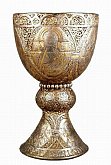Chalice of Tassilo

This Holy Communion chalice, which is named after its founder, the Bavarian duke Tassilo, has to be considered among the most important chalices of the Early Middle Ages. An inscription at the Stipes (Tassilo, strong duke. Liutpirc, royal scion.) enables us to date the chalice with impressive precision - between 768/769 - the year of the marriage of the duke and the princess - and 788 - the year of loss of power of the ‘strong duke’. Moreover, it sheds considerable light on the period when the Carolingians, who were to have a lasting influence on the destiny of Europe, began to amass power and to stage battles against their rivals. Tassilo, who renounced his uncle and guardian Pippin, lost his power to Karl the Great and was pardoned. After the death sentence against him was commuted, he was ordered to spend the rest of his days in a cloister. His chalice has been preserved in Kremsmuenster, a cloister established by Tassilo in his dominion in 777. It has - at least temporarily - been used during Holy Communion there. This supposition is based on the fact that there are signs of wear and tear at the height of the bead moulding which the priest holds tight when he rotates the chalice while giving it to communicants. Its representation, particularly the upper section, the Cuppa, supports an intended liturgical function. It shows Christ - enthroned, flanked by Alpha and Omega - and the four evangelists with their four symbols, so refer to the Lord and his work.




